Plimoth Plantation
Friday, November 3, 2006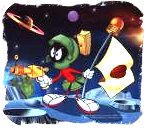 Imagine for a minute that a group of Martians appear one day near your town, arriving in huge ships of a design that you've never seen. At first the Martians seem harmless, only collecting and trading a few things before leaving. They continue to come back over the next few years to do more collecting and trading. But suddenly, you are horrified when the Martians begin to abduct some of your neighbors and take them away in those huge ships. You can’t stop them – they have ray guns.
Imagine for a minute that a group of Martians appear one day near your town, arriving in huge ships of a design that you've never seen. At first the Martians seem harmless, only collecting and trading a few things before leaving. They continue to come back over the next few years to do more collecting and trading. But suddenly, you are horrified when the Martians begin to abduct some of your neighbors and take them away in those huge ships. You can’t stop them – they have ray guns.In addition to the abductions, sometimes when the Martians show up, many of your neighbors sicken and die from strange Martian diseases. Whole neighborhoods are wiped out by the epidemics. It’s a terrible tragedy, but one that the Martians don’t seem to notice or particularly care.
One day, in an abandoned neighborhood where everyone has previously died from Martian sickness, a group of Martians show up and begin to build a little Martian village. It’s the middle of winter, and the Martians are mainly hanging out in their ship except for the construction efforts. You aren’t quite sure what to make of this, but again, they have those ray guns for protection. After a lot of discussion with your remaining neighbors, you decide the best thing to do is help the Martians out a little and hope they will be friendly.
For the most part, this is a good plan, as the Martians have a tough go of it for awhile. They tend to sicken and die when the weather gets cold. Martian crops don’t grow all that well in the area and the Martians go more than a little hungry. Convinced that their ways are infallible, they won’t construct homes in a fashion like yours – Martian houses aren’t near as warm or comfortable in the harsh winters. They adopt a few ideas and practices of yours as a matter of utmost necessity, but for the most part consider you and your neighbors ignorant, uncivilized savages.
The Martians don’t bother you too much at first, although there are incidents. For example, they dig up some of your buried supplies and help themselves to the contents. You also highly suspect that some grave robbing has been going on at the cemetery. This of course bothers you, and you wonder what to do about it.
The Martians love to demonstrate their ray guns whenever you are around. You get the message loud and clear, and don’t make too much of a stink over whatever has happened to grandma and grandpa’s remains. The Martians can be terribly condescending, and have some very strange ideas about religion, but for people armed with ray guns, you decide they could be a whole lot worse.
Over time, you learn the ray guns aren’t invincible. They take a long time to reload, and if you can avoid being shot in the first place, well, then, there are a lot more of you than there are of them. The Martians figure this out also, and build stout, fortified walls around their village. They also build a fort on the top of the hill full of big, huge ray guns they take off the ships. Even if you had wanted to, directly attacking the Martians is probably now out of the question.
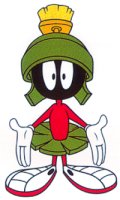 While neither of you trust the other all that much, it’s obvious that it’s better to have the Martians as friends than enemies. You and the Martians negotiate a little over dinner and smokes, agreeing to a few basic guidelines which they insist on calling a treaty. These guidelines include a mutual defense pact - if someone else shows up picking a fight, it will be nice to have those ray guns on your side. The Martians write all this up (in Martian) and ask you to sign. You can’t read it of course, but you scratch your name and hope for the best. After all, they have the ray guns.
While neither of you trust the other all that much, it’s obvious that it’s better to have the Martians as friends than enemies. You and the Martians negotiate a little over dinner and smokes, agreeing to a few basic guidelines which they insist on calling a treaty. These guidelines include a mutual defense pact - if someone else shows up picking a fight, it will be nice to have those ray guns on your side. The Martians write all this up (in Martian) and ask you to sign. You can’t read it of course, but you scratch your name and hope for the best. After all, they have the ray guns.The Martians keep sending back messages to Mars that the land is empty, and to send more supplies and Martians. Mars responds, and more Martians keep showing up. The single Martian village becomes multiple villages. When asked what right they have to land that after all is already occupied, the Martians mumble some nonsense about a petition being granted by their ruler far across the wide void. It doesn’t make a whole lot of sense to you and your neighbors, but again, they have those $%^&# ray guns, and have also hinted on an occasion or two that they know how to make the plague come back. So slowly at first, then faster and faster, the Martians take over more and more of your homeland.
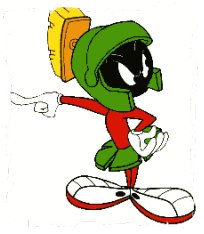
All of this has to end badly, of course, although you and the Martians manage to coexist for about 50 years before it all comes to a bloody end. With the help of new improved ray guns, the Martians almost completely exterminate you and yours, although not before your offspring kill an alarming amount of them. A few of you survive, and are tolerated to live in the area, as long as they don’t bother the Martins at all. Many years later, the descendents of the Martians start going off about zoning and building codes, and will no longer allow your descendents to live in the traditional manner.
Several hundred years later, a few wealthy Martian descendents organize and build a recreation of the original Martian Village as a living museum. Martians in costumes will wander around acting like they live in the recreated Martian village. They speak in old time Martian accents, while demonstrating old time Martian chores. They even shoot off some of the old ray guns. It’s pretty cool, and well done. Martian tourists just love it.
Times have changed, however, and the Martian benefactors figure it would be only fair to tell both sides of the story. In a unique twist, they ask some of your descendents to build a replica of your town. They also ask your descendents to act as guides in the recreated native village, so their point of view can be heard. Most Martian descendents are taught as children that that the original Martians were really great, hardworking guys who were fleeing from religious persecution. They also believe that you and the original Martians got along famously. At last your descendents have a chance to set the record straight a little bit.
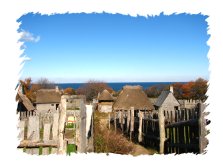
Replace Martians with Pilgrims, Mars with England, Ray Guns with Muskets, and ‘You’ with the Wampanoag Native People, and you’ll have a pretty good idea what Plimoth Plantation is all about. I came up with the explaination above to help answer Vance's question: "why didn't the Indians just kick the Pilgrims out?"
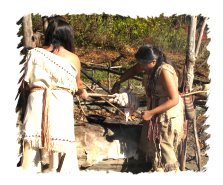
All sarcasm aside, Plimoth Plantation is extremely well done, educational and enjoyable. The presentation of the two cultures, with their very different viewpoints, is handled with sensitivity and surprising frankness. The Wampanoag village is staffed by members of the Wampanoag people, and their viewpoints ranged from helpful and informative to downright bitter. The Wampanoag, although costumed, spoke in the present, and mainly answered whatever questions were presented to them.
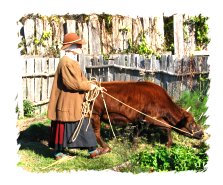
The Colonists village is set in 1627, 7 years after the Pilgrim landing. The staff are in costume and stay in character for the time period, usually performing tasks and chores representative of village life. If you ask them something out of context for their time period, they will intentionally misunderstand, or feign confusion. There isn’t a set script, but the ‘villagers’ go about their way, answering questions put to them.
We had been warned that the place was overrun with school groups in the mornings, and it was. The elementary age groups were fine, but the middle/high school groups were a pain to be around, as the kids were into just about everything except what they were there to see, often being loud and chatty. This made it hard to hear or concentrate on what the villagers were saying. It was far better in the afternoon after the school groups had thinned out, as we were able to carry on multiple lengthy conversations with the Pilgrims. These ranged from philosophical talks on religions, to discourses on Indian relations, interspersed with put downs of the Irish and French!
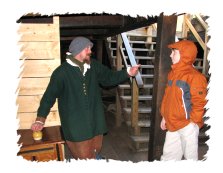
One of the best characters was Robert Coppin, the first mate of the Mayflower. He spent a lengthy amount of time talking with Vance, attempting to 'recruit' him for the return voyage to England. They discussed where Vance would sleep on the ship, the size of his ration of beer (2 pints a day, 1 gallon as an adult), to instructions on how to beat off pirates if needed! Alas, Vance opted to pass up this adventure, to remain a roaming homeschooler in a well colonized country.
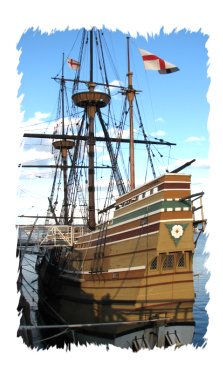
The Mayflower II is tiny, and it’s hard to imagine 100+ people living on the ship at anchor, much less crossing the North Atlantic in the winter. Amazingly enough, the Pilgrims originally bought an even smaller ship, the Speedwell, which proved unseaworthy.
Vance learned a lot from both sides – the museum had a section ‘debunking’ the Thanksgiving myth, presenting a video of a recreation of the actual event based on the only eyewitness account. It would be hard not to learn something if you are able to spend time conversing with the villagers and sailors, as you are engaged in the conversations – it’s not just a monologue on their part. Well worth your time if you are in the area.

Vance: Plimoth Plantation is a recreation of where the Wampanoag Indians and the Pilgrims lived in 1620. The Wampanoag people began dying because European traders brought the plague. Late the Europeans captured and sold the Wampanoag people as slaves. The Pilgrims and the Native People got into a very bloody war 50 years later, the attack of Metacomet. This is known as King Phillip’s War!
Next we went over to the 1627
HISTORY OF THE WAMPANOAGS AND THE PILGRIMS!
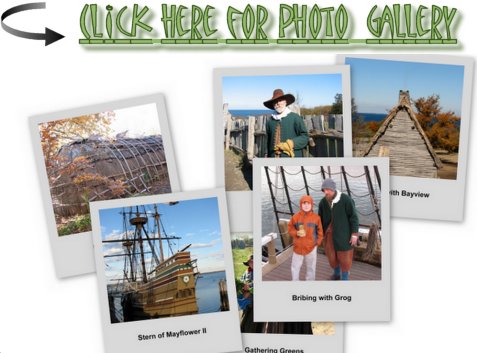








<< Home